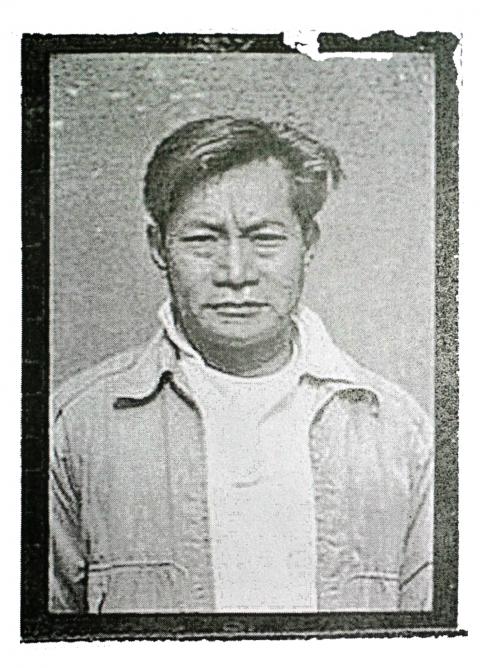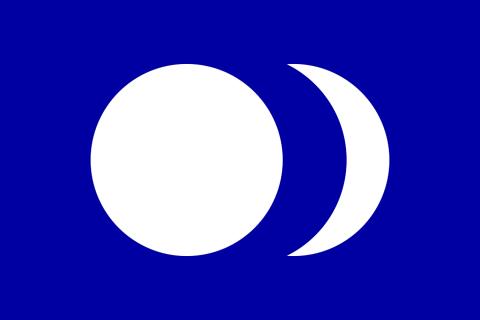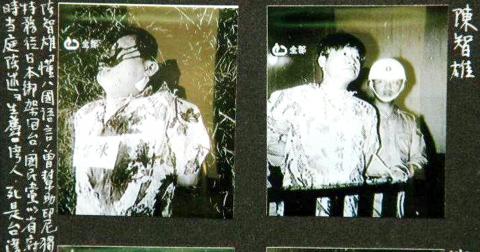Taiwan in Time: Feb.15 to Feb. 21
On the morning of May 28, 1963, Chen Chih-hsiung (陳智雄) was woken up by several executioners, who lifted him up and dragged him out of his cell in the military prison on Qingdao E Road (青島東路).
According to several cell mates, including fellow Taiwanese independence activist Shih Ming-hsiung (施明雄), Chen shouted at the top of his lungs, “Long live Taiwan Independence!” several times before he was taken to the execution grounds.

Photo courtesy of Wikimedia Commons
Shih writes in his book The White Terror in the Dark Ages: A History of Taiwanese Sufferings (白色恐怖黑暗時代:台灣人受難史) that instead of removing Chen’s shackles, the guards cut off his feet so he could not walk to his execution with his head held high.
Another cellmate, Liu Chin-shih (劉金獅), says the guards did so because of Chen’s unwavering belief in his ideals and his refusal to be intimidated by prison officials or the fear of death. Shih writes that during Chen’s many trials, he refused to speak Mandarin, responding exclusively in Hoklo (commonly known as Taiwanese), further angering prison officials.
He was the first independence activist to be executed in Taiwan.

Photo courtesy of Wikimedia Commons
Born on Feb. 18, 1916 in today’s Pingtung County, much of Chen’s life was spent overseas. He first studied abroad as a Dutch language major at Tokyo University of Foreign Languages and was reportedly able to speak English, Japanese, Dutch, Malay, Hoklo and Mandarin.
When Japan conquered the Dutch East Indies (today’s Indonesia) in 1942, the government sent Chen there as either an ambassador or translator. After Japan lost the war, Chen remained in Indonesia as a jewelry dealer.
When the war for Indonesian independence broke out, Chen assisted in Sukarno’s efforts against the Dutch, who were attempting to re-colonize the area, by providing weapons left behind by the Japanese. He was imprisoned by the Dutch for one year because of his actions. After Sukarno won the war, he reportedly honored Chen in person for his help.

Photo courtesy of Wikimedia Commons
Several sources indicate that the success of Indonesia’s independence efforts inspired Chen to do the same for his homeland, which had then been taken over by the Chinese Nationalist Party (KMT).
Chen worked closely with Thomas Liao (廖文毅), who founded the Japan-based Formosa Democratic Independence Party (台灣民主獨立黨) in 1950. It was reportedly through Chen’s connections that Liao was able to attend the 1955 Asian-African Conference in Indonesia.
In 1956, Liao formed the Republic of Taiwan Provisional Government (台灣共和國臨時政府), still based in Japan, and appointed Chen as its ambassador to Southeast Asia.
Sources differ on whether it was under pressure from the KMT or the Chinese Communist Party, but Chen was arrested by Indonesian authorities. Historian Chen Ching-lee (陳慶立) writes in a book on Liao that Chen was eventually released, but lost his Indonesian passport and was deported.
Officially stateless, no country would accept Chen and he flew back and forth between Indonesia and Japan, eventually ending up in Switzerland. From there, he returned to Japan one final time and joined Liao to continue to work for Taiwanese independence.
But the KMT was watching, and its ambassador to Japan worked with local authorities to arrest Chen and force him to return to Taiwan. Chen Ching-lee writes that the KMT promised Japan that Chen would not be punished.
Chen was released shortly after he landed in Taiwan under the condition that he cease all Taiwanese independence activities.
But Chen didn’t stop. He formed another pro-independence group in 1961 with three stated goals: End the brutal reign of the KMT, restore the political, social and economic rights of Taiwanese and establish a free, happy and prosperous Republic of Taiwan.
In the summer of 1962, Chen was arrested by the Taiwan Garrison Command, charged with rebellion and sentenced to death.
In 2013, Chen’s daughter received a final letter written before his execution. On it were the names of his three children and one sentence, written in Japanese: “I died for the people of Taiwan.”
Taiwan in Time, a column about Taiwan’s history that is published every Sunday, spotlights important or interesting events around the nation that have anniversaries this week.

Most heroes are remembered for the battles they fought. Taiwan’s Black Bat Squadron is remembered for flying into Chinese airspace 838 times between 1953 and 1967, and for the 148 men whose sacrifice bought the intelligence that kept Taiwan secure. Two-thirds of the squadron died carrying out missions most people wouldn’t learn about for another 40 years. The squadron lost 15 aircraft and 148 crew members over those 14 years, making it the deadliest unit in Taiwan’s military history by casualty rate. They flew at night, often at low altitudes, straight into some of the most heavily defended airspace in Asia.

This month the government ordered a one-year block of Xiaohongshu (小紅書) or Rednote, a Chinese social media platform with more than 3 million users in Taiwan. The government pointed to widespread fraud activity on the platform, along with cybersecurity failures. Officials said that they had reached out to the company and asked it to change. However, they received no response. The pro-China parties, the Chinese Nationalist Party (KMT) and Taiwan People’s Party (TPP), immediately swung into action, denouncing the ban as an attack on free speech. This “free speech” claim was then echoed by the People’s Republic of China (PRC),

Many people in Taiwan first learned about universal basic income (UBI) — the idea that the government should provide regular, no-strings-attached payments to each citizen — in 2019. While seeking the Democratic nomination for the 2020 US presidential election, Andrew Yang, a politician of Taiwanese descent, said that, if elected, he’d institute a UBI of US$1,000 per month to “get the economic boot off of people’s throats, allowing them to lift their heads up, breathe, and get excited for the future.” His campaign petered out, but the concept of UBI hasn’t gone away. Throughout the industrialized world, there are fears that

Like much in the world today, theater has experienced major disruptions over the six years since COVID-19. The pandemic, the war in Ukraine and social media have created a new normal of geopolitical and information uncertainty, and the performing arts are not immune to these effects. “Ten years ago people wanted to come to the theater to engage with important issues, but now the Internet allows them to engage with those issues powerfully and immediately,” said Faith Tan, programming director of the Esplanade in Singapore, speaking last week in Japan. “One reaction to unpredictability has been a renewed emphasis on